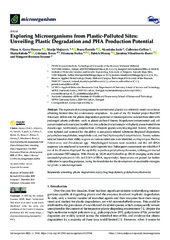Prikaz osnovnih podataka o dokumentu
Exploring Microorganisms from Plastic-Polluted Sites: Unveiling Plastic Degradation and PHA Production Potential
| dc.creator | Herrera, Diana A. Garza | |
| dc.creator | Mojićević, Marija | |
| dc.creator | Pantelić, Brana | |
| dc.creator | Joshi, Akanksha | |
| dc.creator | Collins, Catherine | |
| dc.creator | Batista, Maria | |
| dc.creator | Torres, Cristiana | |
| dc.creator | Freitas, Filomena | |
| dc.creator | Murray, Patrick | |
| dc.creator | Nikodinović-Runić, Jasmina | |
| dc.creator | Brennan Fournet, Margaret | |
| dc.date.accessioned | 2023-12-03T21:43:36Z | |
| dc.date.available | 2023-12-03T21:43:36Z | |
| dc.date.issued | 2023 | |
| dc.identifier.issn | 2076-2607 | |
| dc.identifier.uri | https://www.mdpi.com/2076-2607/11/12/2914 | |
| dc.identifier.uri | https://imagine.imgge.bg.ac.rs/handle/123456789/2225 | |
| dc.description.abstract | The exposure of microorganisms to conventional plastics is a relatively recent occurrence, affording limited time for evolutionary adaptation. As part of the EU-funded project BioICEP, this study delves into the plastic degradation potential of microorganisms isolated from sites with prolonged plastic pollution, such as plastic-polluted forests, biopolymer-contaminated soil, oil-contaminated soil, municipal landfill, but also a distinctive soil sample with plastic pieces buried three decades ago. Additionally, samples from Arthropoda species were investigated. In total, 150 strains were isolated and screened for the ability to use plastic-related substrates (Impranil dispersions, polyethylene terephthalate, terephthalic acid, and bis(2-hydroxyethyl) terephthalate). Twenty isolates selected based on their ability to grow on various substrates were identified as Streptomyces, Bacillus, Enterococcus, and Pseudomonas spp. Morphological features were recorded, and the 16S rRNA sequence was employed to construct a phylogenetic tree. Subsequent assessments unveiled that 5 out of the 20 strains displayed the capability to produce polyhydroxyalkanoates, utilizing pre-treated post-consumer PET samples. With Priestia sp. DG69 and Neobacillus sp. DG40 emerging as the most successful producers (4.14% and 3.34% of PHA, respectively), these strains are poised for further utilization in upcycling purposes, laying the foundation for the development of sustainable strategies for plastic waste management. | |
| dc.language | en | |
| dc.relation | European Union’s Horizon 2020 Research and Innovation program (grant number: 870292 (BioICEP) | |
| dc.relation | European Union’s Horizon Europe EIC Pathfinder program (grant number: 101046758 (EcoPlastiC) | |
| dc.relation | This work was supported by national funds from FCT—Fundação para a Ciência e a Tecnologia, I.P. (Portugal), in the scope of projects UIDP/04378/2020 and UIDB/04378/2020 of the Research Unit on Applied Molecular Biosciences—UCIBIO and LA/P/0140/2020 of the Associate Laboratory Institute for Health and Bioeconomy—i4HB. | |
| dc.rights | openAccess | |
| dc.rights.uri | https://creativecommons.org/licenses/by/4.0/ | |
| dc.source | Microorganisms | |
| dc.source | Microorganisms | |
| dc.subject | biopolymers | |
| dc.subject | plastic degradation | |
| dc.subject | polyhydroxyalkanoates | |
| dc.subject | screening | |
| dc.subject | upcycling | |
| dc.title | Exploring Microorganisms from Plastic-Polluted Sites: Unveiling Plastic Degradation and PHA Production Potential | |
| dc.type | article | en |
| dc.rights.license | BY | |
| dc.citation.issue | 12 | |
| dc.citation.spage | 2914 | |
| dc.citation.volume | 11 | |
| dc.identifier.doi | 10.3390/microorganisms11122914 | |
| dc.identifier.fulltext | https://imagine.imgge.bg.ac.rs/bitstream/id/508632/bitstream_508632.pdf | |
| dc.type.version | publishedVersion |

